Arrival In France
Marseille – 7 January 1957
When we arrived in Marseille, we were greeted by government officials and representatives to help families with their passports to facilitate entry into the country. I cannot recall how long we were at the port of Marseille, as many families needed to be processed. We were grouped together as a family as did many others, and agencies took charge of assisting in providing transportation and accommodation. This was the start of a transition through several locations in France from Carcès to Draguignan and eventually Bordeaux, where we finally settled, at least initially. As new refugees, we were required by the government to have paperwork stamped in each town/city's jurisdiction.
Carcés - 7 January 1957 to 13 February 1957
Once formalities were completed, we boarded a tour bus that was waiting to take us to Carcés, a small quaint country town 100 km (about 60 mi) from Marseille. Traveling through the beautiful and picturesque Provence countryside was much smoother after being at sea for almost 2 weeks. Carcés is in le Var department also known as Provence-Alpes Côte d'Azur region in Southern France.
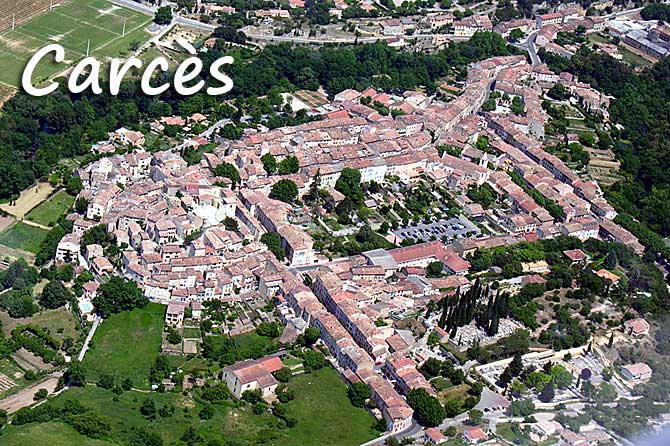
Aeriel view of the town of Carcés, France
After this short trip,
we arrived in the center of town where the bus pulled in front of our hotel,
"hôtel chez nous."
The temporary stay at this hotel was organized by the French government
in conjunction with the town of Carcès, municipal authorities.
Upon stepping down from the bus, the hotel owners greeted and welcomed us.
They quickly gave us a tour of the hotel and showed us our rooms.
They helped us get settled and feel comfortable in our new environment and made us feel like family.
We could discern Arabic spoken principally between family members;
however, French was the prominent language spoken.
It felt authentic especially when speaking with hotel guests,
people who visited and the hotel owners.
As night fell, we were all invited into the main dining room for supper.
We could smell the aroma of hot cooked food permeating.
On each table, there were French bread (baguettes), dishes of fresh butter
and abundant red wine poured in carafes
as we were in the heart of wine country of the Provence region.
It was winter and the climate was much colder than what we were accustomed to. We had to get habituated to frost and cold temperatures. The scenery was unlike anything we were used to. In the brisk morning air under gray skies, a distinct smell permeated from burning wood and you could see smoke coming from chimneys. It was January and the sight of snow slightly covering the ground was completely foreign to us. We had never experienced anything like this before. We stayed in Carcès, our first destination, from our arrival on 7 January 1957 until 13 February 1957, which does not seem like an exceptionally long time. At first, we were not aware how long we would be in Carcès, but it was important for me to be in school, given the disruptions which we encountered from our unsettling time in Alexandria and moving to another country. I went to L'Ecole communale in Carcès (the local elementary school in the neighborhood), where classes were already underway. As a newcomer, I felt the pupils were unwelcoming, which seemed typical as it takes a while for a new student to be accepted or integrated into a new school. I had not had the opportunity to get to know any of the students or to get acclimated as would be the case starting at the beginning of a school year.
Carcès was a small community where people knew one another. The hotel we stayed in was frequently visited by local people who stopped by for a meal, a drink or to chat. It was not unusual to hear people talking until late in the night, as it seemed to be a friendly gathering place. It took a little getting used to when I was trying to fall asleep, as the noise from the dining room could be heard in the hotel rooms upstairs. I am sure there were lots of stories being exchanged while getting to know one another. At night especially, I remember being quite scared of one person who stood out. This was a gentleman with a heavy beard who appeared older. As I felt great fear in his presence, it got worse as time went on as it became evident that I was running away trying to avoid him. As soon as he came into the hotel, I would quickly escape to my room upstairs. It seemed so frightening that I remembered my cousin Adrienne reassuring me and staying with me until I fell asleep. I also saw this gentleman on my way to school in the morning. I had already formulated my apprehension and opinion. There was nothing that convinced me otherwise. I would beg Albert, Sam or one of my cousins to walk me to school. Deep down where I felt reassured. I am certain he was probably a kind man meaning no harm, but at that time I felt more secure being accompanied.
We slowly fell into a routine even though this stop was supposed to be short. I don't recall having much time to play as the days flew by, and the weather outside was not conducive for outdoor activities. I don't remember seeing kids having fun or many toys except for little girls playing with dolls. I recall an incident with a little girl who was carrying a doll when unexpectedly one of the arms of the doll became loose. It was dangling from a metal spring. Suddenly, the spring quickly coiled up into Robert's temple lodging near his eye. Robert, who was being held in someone's arms started screaming. He was just about a year and half old. It was an intense and scary situation and there was great panic with people surrounding him. Tino was nearby and upon realizing what was unfolding, immediately and carefully held Robert and the doll's dangling arm and rushed to a nearby clinic. It was a very tense situation as it could have been worse but fortunately, everything turned out well following this frightening experience. I remember there were several onlookers as this unfolded. Everyone seemed quite concerned, but later that day back at the hotel, there was a sigh of relief knowing that everything turned out well.
Our stay in Carcès was coming to an end as we were slated to move to the next town, which was also in the Var region. As refugees/immigrants, we were required by the French ministry of the interior to file a change of residence form each time we moved from one place of residence to the next. Our first move was when we departed from Carcès to go to Draguignan.
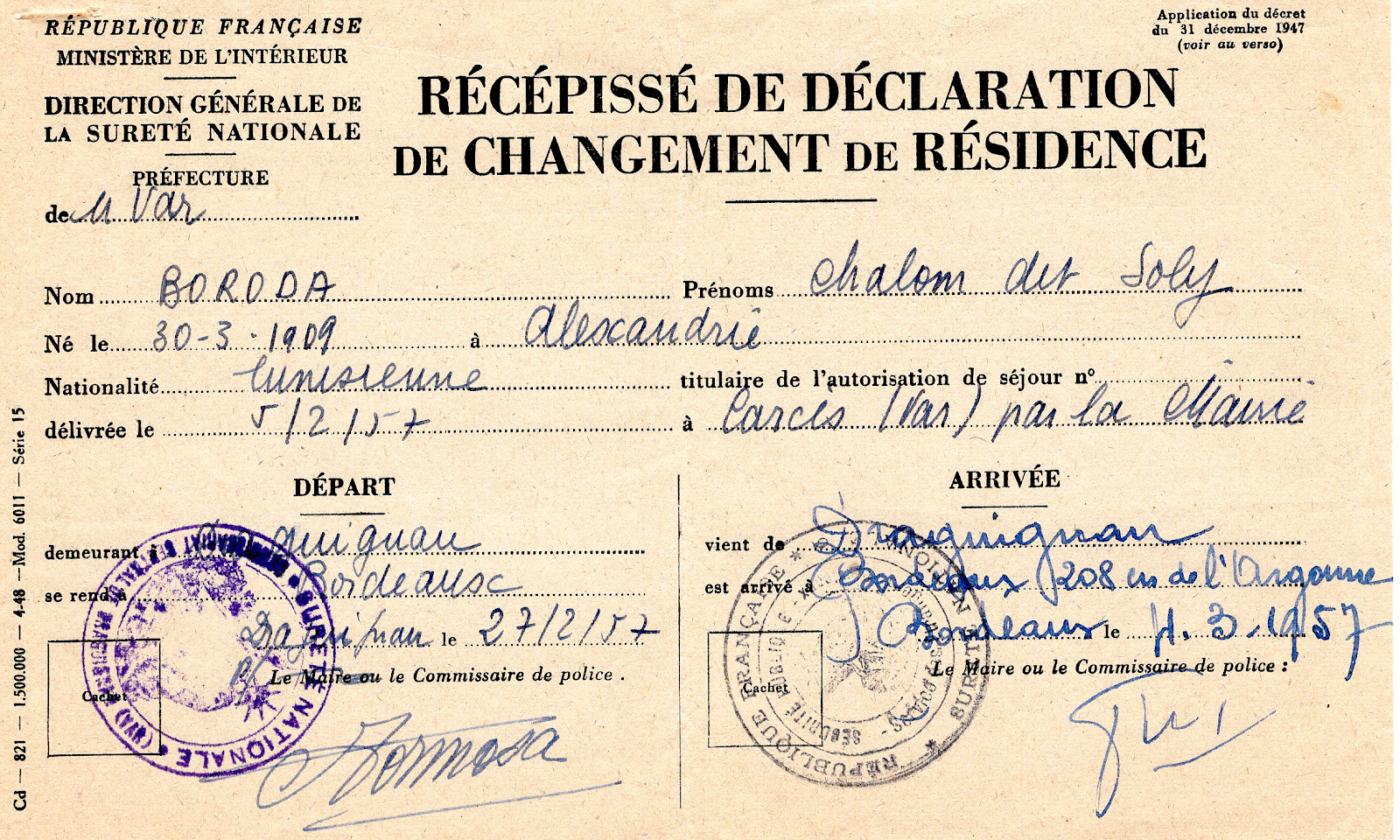
Stamped document change of residence from Carcès to Draguignan, France.
Each community we reached in France seemed to be temporary. It was unsettling because we did not know how long we would be staying in the different places that provided us with temporary housing. I am not sure what dictated why we ended up in the different towns, at least in Carcès and Draguignan in the beginning. I wondered if it was due to its proximity to Marseille, as both were in the Var region in the Provence-Alpes Côte d'Azur region in Southern France. There was no time to settle in any of these communities, hence no chance for stability or for us as kids to attend any meaningful schooling as I already mentioned in my brief experience in Carcès.
Draguignan - 13 February to 4 March 1957
As in Carcès, the people of Draguignan also welcomed us when we arrived at hotel Sainte Marguerite. We were greeted with warm hospitality and accommodation. Shortly after settling into our rooms, we could smell the aroma of soup and hot cooked food. To accompany our meal, French baguettes were also in abundance, and of course wine was always a great accompaniment with every meal. In the early hours of the morning, again the fresh smell of bread welcomed us, as did the smell of warm croissants and fresh pastries, along with espresso coffee and café au lait which permeated the room.
We had been accustomed to a European mode of life back in Egypt, but in native France, it was even more authentic. In this region of southern France, the people were very friendly. Whether it was in Carcès or Draguignan, we felt a warm closeness. Draguignan was a short stay, and we did not have the chance to experience living in this small community. As it came time to depart, we felt a sense of sadness like what we experienced when we left Carcès.
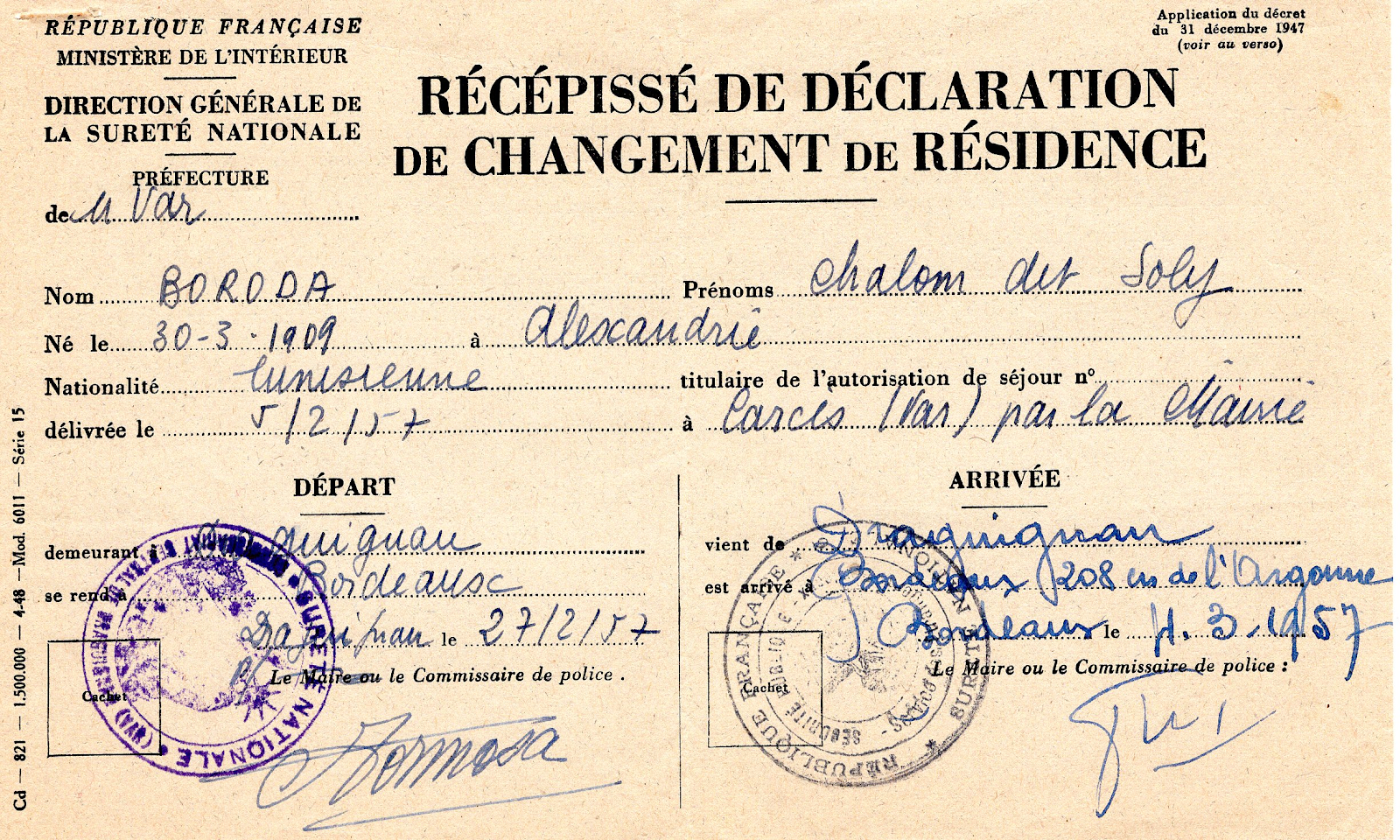
Stamped document change of residence from Draguignan to Bordeaux, France
For the families that were with us through these two initial stops, we were slated to be together with a destination to Bordeaux. Many of the other families who had arrived in Marseille originally had either gone to other towns within France, or other countries. My childhood friends, Arlette and Andre Lusena, who were on our boat went to Italy, as their father was from Italian origin. It would take quite a few years until I reconnected with them, and it was not until we moved to Marseille. Communication was principally by written letter, occasionally a telegram, but telephone communication was essentially nonexistent. It was wonderful to hear from friends and families from across the globe, all sharing their individual experiences as they settled in different parts of the world. There were lots of stories of hardship while getting acclimated into foreign territory, and lots of stories reminiscing of life in Egypt.
Our next adventure was moving to Bordeaux, which was more conducive for our cousins who were going to study medicine. Before settling in different parts of Bordeaux, we were housed for a brief time in a temporary site which was an old military camp. The address was Cour de l'Argonne in Bordeaux proper. I remember seeing a letter sent by Nonna Rifka Sades in Israel addressed to Grandma Rachel at that address. This was the first letter directly sent from Israel to Grandma in France.
In this military camp, which was a makeshift housing, each family was separated by a tall partition. We could hear each other talking even after the lights went out for the night. I am sure it must have been very scary venturing in yet a new environment along with all the worries of settling into a new city and awaiting what was to come. Our day consisted of waiting for formalities to determine our next steps for housing or playing in the open field.
As the camp was no longer being used, there was a pile of debris covered by a tarp in one of the corners, which I thought was fun to climb. Unfortunately, I took a tumble and fell onto my thumb which quickly became dislocated. Quite scared and in a lot of pain, I was quickly whisked and taken to the hospital nearby, where I underwent a procedure known as closed reduction to reposition my thumb. It was a very traumatic and painful experience as I recall being wheeled into the operating room.
After our stay at the foyer militaire, “military camp”, each family was provided with options where to move in Bordeaux. One of the choices was a place that belonged to the city which was located at Rue Belleville. Our cousins, Tino, Andre and Adrienne, with Aunt Laura and Nona Rosa chose there, as did other families. I recall, it had accommodation for bedrooms to house each family, a main kitchen and a large common area. The common area was where we gathered during Jewish Holidays, and Grandpa Soly would lead all the prayers along with some help from family members. Grandpa Soly seemed to always lead the bulk of the prayers. This took place for each holiday while we lived in Bordeaux. Rue Belleville happened to be one of the sites that housed most families. Others were given different options throughout the city under the auspices of the government and formalities.
We were provided housing on the grounds of the Great Synagogue of Bordeaux, located at Rue Labirat. The name of the street has since been changed to Rue du Grand Rabin Cohen, named after the Great Rabbi of Bordeaux, in honor of his legacy to the Jewish Community of Greater Bordeaux. I had the chance to meet Great Rabbi Cohen when we lived at la Rue Labirat, and found him to be very fascinating. He shared a lot of the history of the temple and the Jews in the Bordeaux community during World War II, as well as his story and escape from the Nazis.
Our home was at 8 Rue Labirat during the time we lived in Bordeaux. As I remember, there was only 1 room per floor. On the ground floor, was a classroom for the Hebrew school. We occupied a room on the second floor, which was a combination kitchen with a cast iron stove, a small table and room for Grandpa Soly and Grandma Rachel's bed. On the top floor, there was a bathroom and a bedroom with beds for all four of us, Albert, Sam, me and Robert. There was also a large desk we used to do our homework.
In the back of the building we lived in, we had the view of the temple's inner courtyard. To the right, there was a side entrance to the main synagogue. Across the courtyard was a smaller chapel, which was mostly used for daily minyans and during the winter when there were smaller congregants gathering for prayer. On the left side of the courtyard was the entrance to a function hall and the housing quarters for the Chamash (in charge of the building) and his wife. The Chamash was present at all services. He ensured decorum and was charged with organizing the honors for section of the prayers and overseeing the security of the temple. His name was Monsieur Perer. He was an icon at the synagogue with a long tenure. I was always amazed at the outfit he wore during services. It was all black with a distinctive hat. It made a great impression.
La Grande Synagogue de Bordeaux or Great Synagogue of Bordeaux had an impressive façade, which could be seen through a solid iron gate from the street.

Picture of front of synagogue of Roman motif showing large marble steps leading up to the entrance, flanked by 2 large towers on either side.
("Grande synagogue de Bordeaux" by Jibi44 is licensed under CC BY-SA 3.0.)
The main doors to the synagogue were only open during services, otherwise the three large doors were always kept locked. Once entering from the street, a large foyer led to another 3 large doors which led into the sanctuary. From the foyer, there were large marble staircases leading to the upstairs where women sat.
The synagogue was a main tourist stop for many people visiting Bordeaux. It was not unusual to get a knock on our door with people interested in seeing the inside, as we lived on the grounds. I took much interest and appreciation in sharing in the joy of offering to show the inside of the synagogue to anyone who was interested. There was still an element of trust in opening the doors to perfect strangers in those days, as today, the synagogue is heavily guarded and visiting is done strictly by appointment.
The inside of the synagogue was very impressive. The ground floor had oak pews with names of congregants, members of the Consistoire or members of the congregation. Women sat on the second-floor balcony. It was very typical in Sephardic synagogues to have a delineated area in the center, called nef, which was an enclosed area that was surrounded by tall oak walls. This is where the choir was led and where the organ keyboard was located. (We, Albert, Sam and I had become members of the choir, known as Enfants de Coeur during the time we lived in Bordeaux). Cousins Allegrina and Benny were also part of the choir. At certain times, specifically during wedding ceremonies, there would be a small orchestra ensemble which would accompany the organ and the choir. We had learned all the unique melodies which were played at Shabbat services and Jewish Holiday Services. The organ piping system was located on the right side upon entering the temple. It was a structure with ventilated panels to allow the beautiful, amplified sound of the pipe organ, which echoed beautifully in this large edifice. The synagogue had the addition of a beautiful Soprano who accompanied the choir during certain services and at weddings.
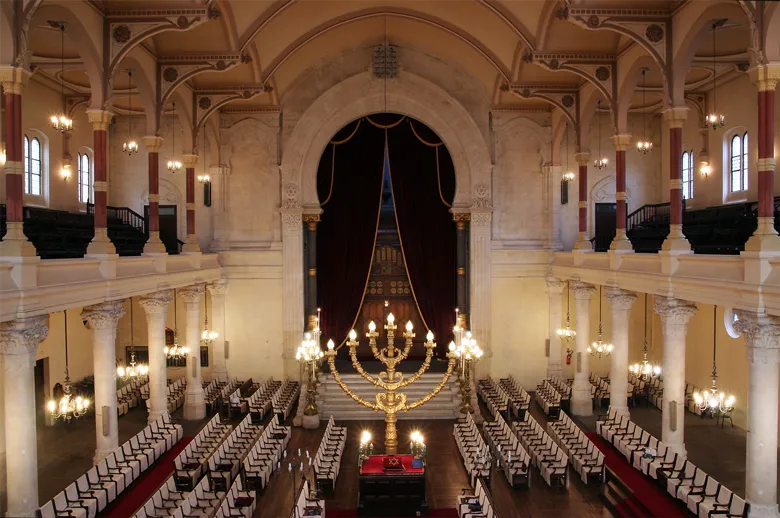

Great synagogue of Bordeaux inside look
I described earlier the enclosed area in the center of the synagogue, which can be seen in the picture above. This was known as the Nef. At the very front of the Nef were steps on both sides to go up to the “Teba” (Bimah), where our Chazan, Mr. Zerbib, led services. The Teba faced the ark. In front of the Teba was a very large golden 7 branch menorah, which was a focal point and located several feet from the large marble steps leading up to the ark. The ark was known as Echal.
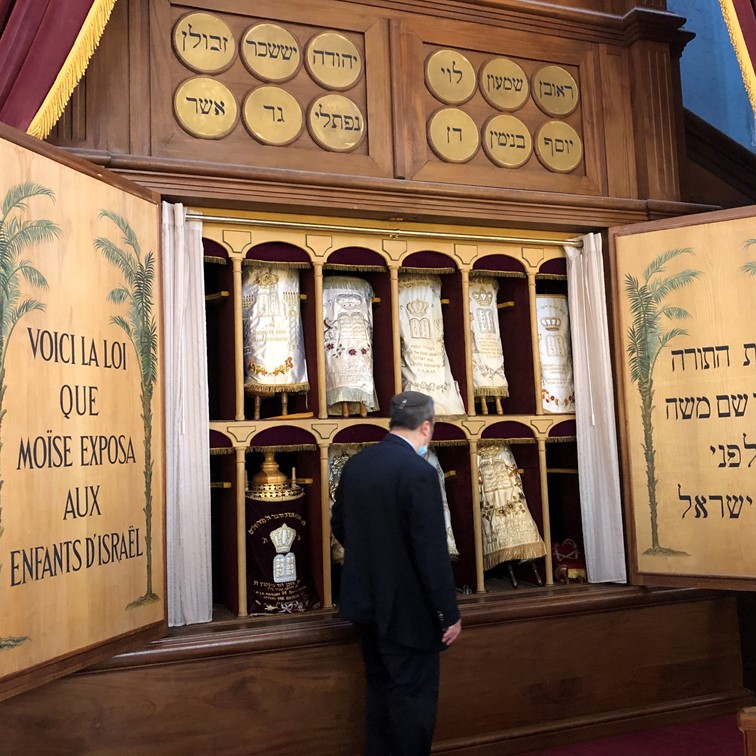
This is where 12 Sefer Torah scrolls were kept, corresponding with the 12 tribes
I recall visitors being in awe when they entered while observing the beauty of the sanctuary. What culminated their visit was seeing the inside all lit up and when the heavy red curtai,n which hung from the very top of the sanctuary, was pulled open. Once the curtain was gathered open, you could see the doors behind which were located the Sefer Torahs. As the ark was opened, there were lots of moments of silence and reflection. On certain occasions, visitors could get a glimpse at the Khupah that the Congregation readied for a wedding, which stood in front of the ark.
This Grand Synagogue of Bordeaux had recently celebrated 140 years and was witness to so much history including its occupation by the Nazis during WWII.
There is much more to share about our story of living in Bordeaux. While living on the grounds of the great synagogue, we were an integral part of the Jewish community. As I mentioned, we were all part of the choir and both Albert and Sam were Bar Mitzvat there.
Thank you for your interest